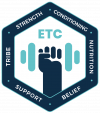Building muscle is hard work. Much harder than most coaches and personal trainers might have lead you to believe. Especially if you have been training for a while or are over 40.
Here are the 3 most important things to consider on if you are wanting to maximise your chances of building bigger biceps in 2022:
#1
Train Hard.
If you want to build muscle, you need to challenge your muscles. Building muscle will only occur when a sufficient stimulus is placed on the muscle to cause it to adapt and gain size, and strength.
This means lifting heavy weights!
Not just going through the motions, lifting the same weights every time you step into the gym.
It means pushing yourself to lift heavier weights for more reps over time. This is where the magic happens.
It means following a structured, progressive training plan that includes a variety major exercises, such as squats, deadlifts, pushing and pulling movements.
These movements need to be trained frequently, trying to add a small amount of weight or a couple of reps to make it just a little bit harder each time.
How often do you need to train to build muscle?
For most people, 3 sessions per week will be enough. As your training experience increases and you gain more strength and muscle, this can increase up to 4-6 sessions per week.
#2
Eat plenty
To help fuel your hard training, you need energy. This comes in the form of calories!
Eating 1000 calories and having half a lettuce for your lunch doesn’t exactly scream high performance, does it now?
To really maximise muscle gain, you should eat in a calorie surplus; that is, you consume more calories than your body uses in a day.
A surplus of about 300 above your maintenance calories would be a good place to start!
Protein.
Once you are eating enough calories to fuel your efforts, the next step is protein!
Protein is the building blocks of muscle tissue, so you need enough to create the new muscle tissue and repair the damage caused by lifting heavy weights.
On average, people who eat higher protein diets have more muscle and less body fat than people who consume much lower amounts of protein.
Aim to eat at least a palm sized serving of a high protein food with each meal, or for the MyFitnessPal extraordinaires amongst you, try to aim for 1.6-2g per KG of bodyweight per day.
#3
Recovery is key
You could be following the best training plan the world has ever seen, getting plenty of protein and just the right number of calories yet still struggle to gain muscle, simply because you aren’t getting enough sleep.
Simply put, during sleep is when our muscles repair and grow, and to get a bit more technical, it is when metabolites and free radicals that damage our body are removed.
A poor nights sleep will have a negative effect on all aspects of your life, from your energy levels, to your appetite, to your food choices, and when it comes to muscle growth, your performance in the gym!
Unfortunately, 4 hours of sleep isn’t going to cut it.
We would advise aiming for at least 7 hours of quality sleep per night.
and that’t 7 hours ASLEEP, not in bed. So if 7 hours is the target, then you need to probably be in bed before the time you want to be asleep by.
We understand that this isn’t realistic for many, especially the parents among you.
5 is better than 4, 6 is better than 5, 7 is better than 6. Your best is the best you can do!
So to put it simply: lift challenging and progressively heavier weights, eat plenty of calories and protein to fuel your training, and get plenty of quality sleep to maximise your recovery!
– Coach Kyle




